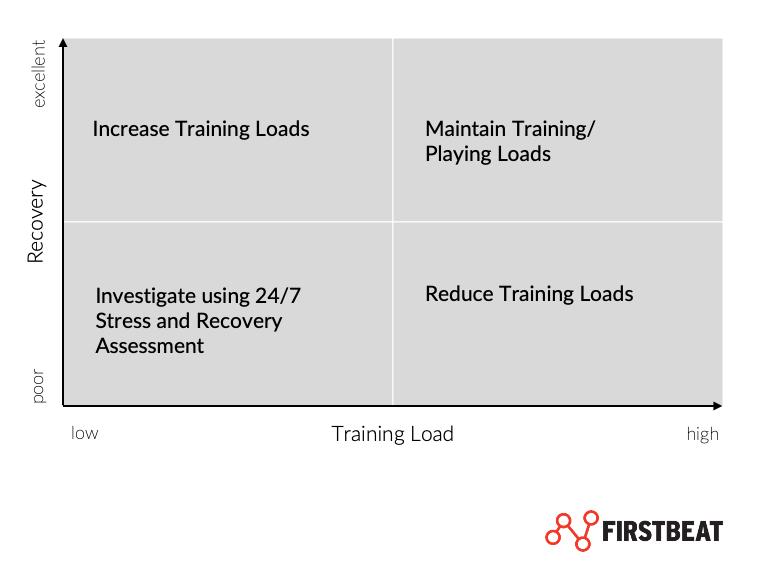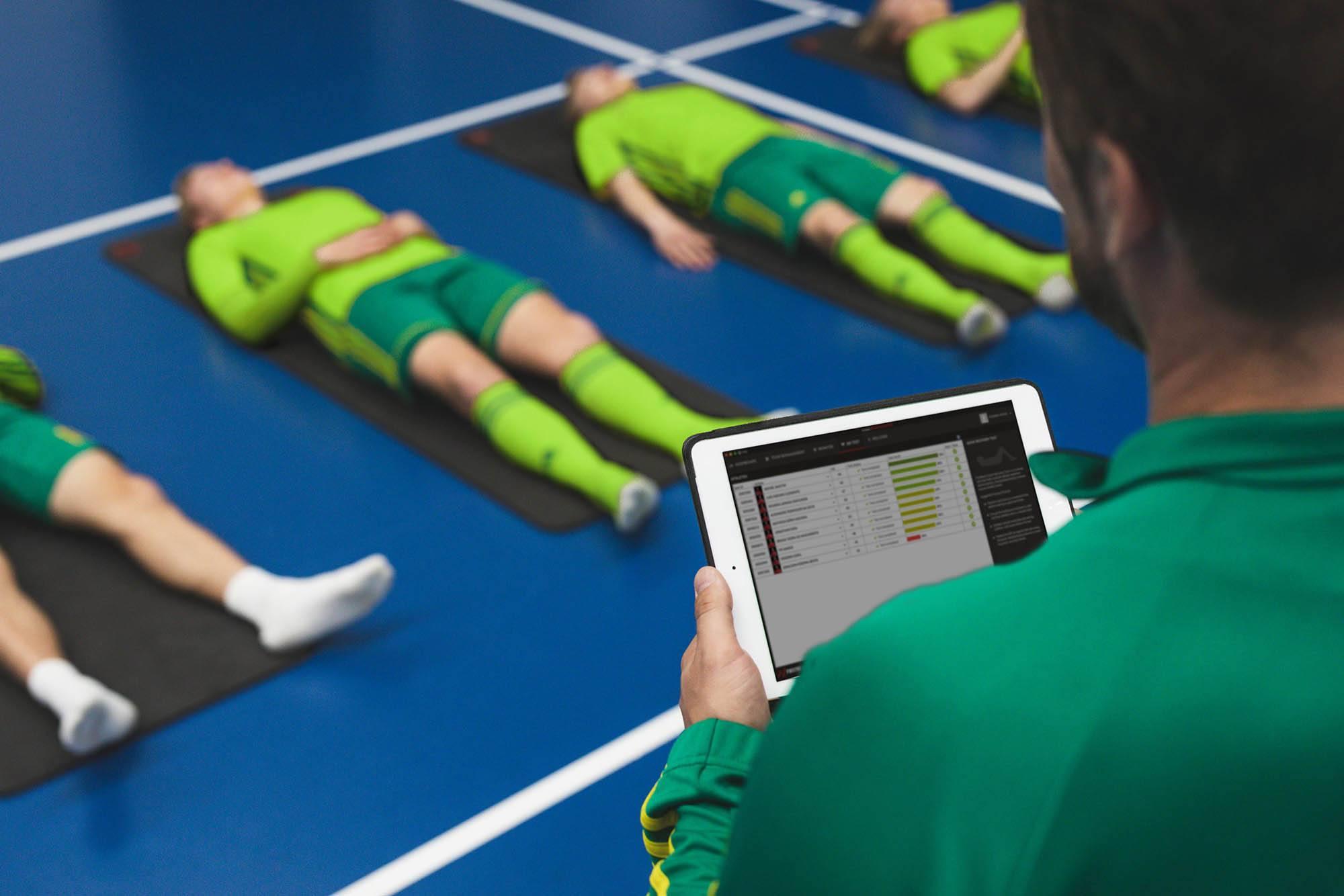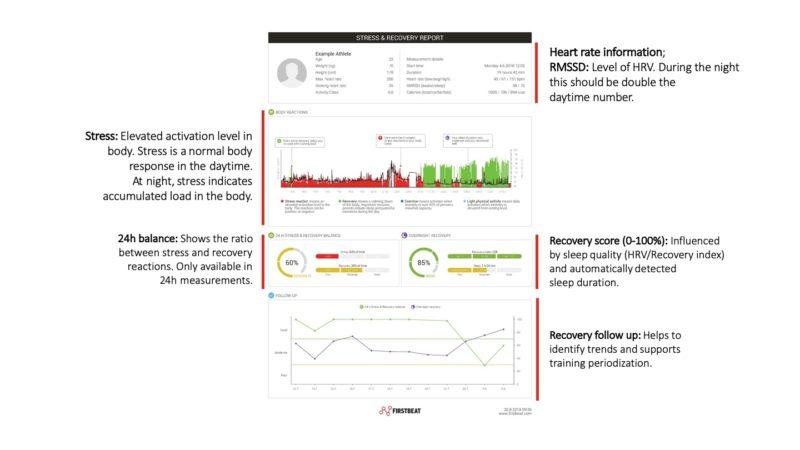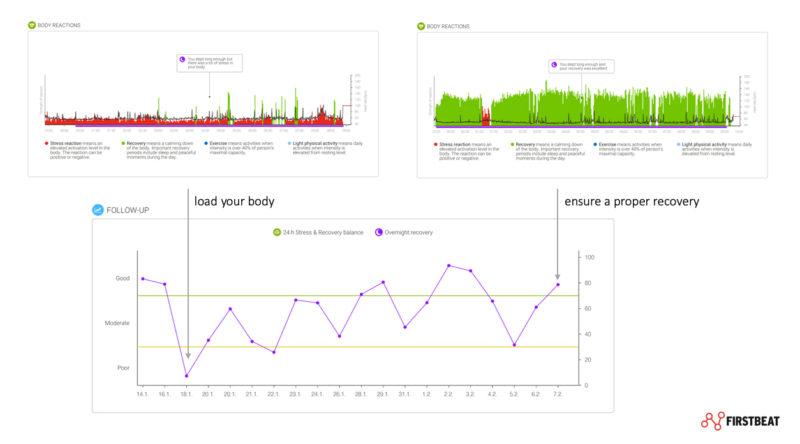To get the full picture and a more complete idea of what is happening with your athletes you should also track their recovery and readiness.
Firstbeat Sports offers two tools for tracking athlete recovery and readiness – the Quick Recovery Test (QRT) and the 24/7 Stress & Recovery Assessment. Both tools offer valuable insights into how your athletes are coping with the demands being placed upon them.
Many things can affect the recovery status of an athlete beyond simply the physical loads they deal with in their sport. Some of these factors can include:
- Training and competition load
- Physiological status, health condition, infections, etc.
- Injuries, fear/anxiety of reinjury, decreased self-confidence
- Sleep disturbing effects, e.g.:
- Late evening or night games, or inconsistent game schedules
- Environmental conditions, e.g. bright lights in the stadium/venue
- Irregular sleep schedules, caffeine, or alcohol intake
- Engagement and arousal of competing
- Team travel schedules/fatigue
- Pressure of team and individual success
- Media relations, publicity
- Micro stressors, daily life hassles
- Major life events, life stress, studying, working, family issues, personal relationships, etc.
The above factors clearly show we need to consider not only training but the athlete as a whole to ensure successful recovery and readiness. They have lives outside of their sport and the two do not exist in isolation.
It is well established that HRV is an indicator of stress and general well-being (e.g. Delaney & Brodie, 2000; Geisler, et al., 2010; Munla, et al., 2015). This is relevant to athletes as stress is a factor in increased injury risk (Galambos, et al., 2005; Maddison & Prapavessis, 2005; Slimani, et al., 2018). It is not just training loads that influence injury risk.
1. Quick Recovery Test
The Quick Recovery Test (QRT) should be used to provide a regular, quick and easy snapshot of how your athletes are reacting to the loads they are facing. The QRT results themselves can be used in two primary ways – assessing recovery status and assessing readiness to train.
Assessing Recovery Status
When assessing recovery status, the data from the QRT is best analyzed on a longitudinal basis to get a picture of how your athlete is responding over time. This is because HRV can fluctuate day-to-day and if only considering scores in isolation you risk making less accurate judgments.
The timescale for recovery can also vary significantly (Nedelec, et al., 2012). This is backed up by research from Plews and colleagues (2013) who found weekly HRV was correlated with improvements in running performance.
It is preferential to use the seven-day QRT average in the Firstbeat Sports system. Or, if you are using the Data Export function, a three or four-day rolling QRT average can also work well. It is important to conduct the QRT as often as you can otherwise you will face the issue of natural fluctuation affecting the average and reducing the smoothing effect of multiple measurements.
Several other studies have shown how HRV can be used to assess adaptations to training. Therefore, we recommend tracking the RMSSD for the purpose of monitoring adaptation, as well as tracking the QRT Scaled % to assess recovery.
Beyond Plews, et al.’s 2013 study showing associations between HRV and 10km running (Plews, et al., 2013), see below for further examples of using the QRT and HRV in this way:
- HRV was associated with an increase in plasma volume and aerobic fitness (Buchheit, et al., 2011)
- HRV related to changes in VO2max in female soccer players (Esco, et al., 2016)
- Larger increases in HRV were associated with greater performance improvement in the Yo-Yo IR1 test (Nakamura, et al., 2018)
An effective way to use the multi-day rolling QRT average is to track it alongside Acute Training Load.
There will be periods when you are overloading your athletes and you would expect to see lower QRT results in these instances. Similarly, if you have a planned de-loading period or taper you should expect to see an increase in QRT scores.
You will see adaptation when Acute Load is either:
- The same with an improved QRT / HRV, or
- Acute Load is elevated and QRT / HRV has stayed at a similar level.
This will indicate the athlete is either:
- Having a lower response to the same load, or
- The same response to increased load
Both of these instances are an indication of positive adaptation. When the opposite applies this indicates periods of fatigue, overreaching or even overtraining.
Using the data:
As described above, an athlete’s recovery data can inform you about their current training status, but what can you do with this in practical terms? The below matrix (Figure 1) provides a useful guide for what action you may need to take, or not take, in different circumstances.

Figure 1. Recovery and Training Load Intervention Matrix.
Example Cases:
Excellent Recovery: High Training Load – Training Loads are high, but your athlete has high recovery scores. This suggests they are coping well with the current demands being placed upon them and can continue as they are.
Excellent Recovery: Low Training Load – The athlete is capable of coping with more. Consider increasing their training loads unless you are in a de-loading phase.
Poor Recovery: High Training Load – Your athlete has high training loads but is struggling to cope with them. You should consider reducing their load to allow them to recovery and adapt. If you are in an overloading phase this may be the outcome you are seeking, but remember to allow appropriate time for recovery after this phase is complete.
Poor Recovery: Low Training Load – Your athlete is struggling to recover but it is unlikely to be due to current training loads. You should use the 24/7 Stress & Recovery Assessment to investigate possible external causes such as stress balance, quality and duration of sleep, and lifestyle factors.
Assessing Readiness to Train
The QRT can also be used as a measure of readiness to train – i.e. how well prepared is that individual for training on that specific day?
This may seem slightly contradictory to the above, however, there is evidence in the literature to show that HRV can also be used to guide daily training loads as well as assessing longer-term recovery and adaptation. Some examples include:
- Chrismas, et al. (2019) found that smartphone-derived HRV collected in the morning pre-training may provide an indicator of readiness to train within elite soccer.
- Cornforth, et al. (2015) had results to show that in-game player performance, measured using GPS, could be predicted by HRV with a correlation coefficient of >0.7.
- Nuuttila, et al. (2017) conducted a study with two training groups, one predetermined and one guided by their morning HRV. The HRV-guided group showed greater improvements in performance compared to the predetermined group.
Within the Firstbeat Sports dashboard, the QRT scores are graded ‘Excellent’, ‘Good’, ‘Moderate’ and ‘Poor’. The specific percentage score is also given. You can use these categories to guide and individualize your daily training in order to maximize the results you get, capitalizing on days when an athlete is in good condition or allowing more recovery when they need it.
For example, if an athlete gets a ‘Good’ or ‘Excellent’ score you could increase or intensify their training for that day. If their QRT score is ‘Poor’, decrease the demands you had planned. A ‘Moderate’ score means you continue with the original plan.
2. 24/7 Stress & Recovery Assessment
The 24/7 Stress & Recovery Assessment gives you comprehensive information on how an athlete copes with stress and recovery in their wider life, as well as their sporting life. This is an extremely powerful tool that can be used to influence real change in the overall wellness of your athletes, which, in turn, will likely improve athletic performance.
The assessment can also be used to evaluate travel schedules before/after competition. Are your athletes getting enough recovery after traveling to be able to perform at their best? Or, are they achieving enough recovery before you’re expecting them to train again?
Interpreting the Report
Athlete Assessment
The QRT Scaled % scores are based upon the data that you have recorded for an individual. However, if an athlete is presenting suppressed scores for every measurement the system may calculate this as normal, returning an acceptable % despite the athlete not being in great shape.
This is where you need to look beyond the % and check on the RMSSD (this can apply to the QRT section as well). See Table 1 below for a great example of this.
| Resting HR | Sleep Duration | Recovery index (range) | Nocturnal RMSSD (range) | |
|---|---|---|---|---|
| AVERAGE | 37.8 | 8.37 | 102-228 | 55-101 |
| TOP PERFORMING ATHLETE | 35 | 8.39 | 100-270 | 62-127 |
| OVERTRAINED | 48 | 8.12 | 15-68 | 10-40 |
Table 1. Example athlete recovery measurement data.
As you can see, the ‘Overtrained’ athlete had a low Recovery Index range, although this was ‘normal’ for them throughout the data collection period so you can see the potential for missing this. You can also see that their nocturnal RMSSD range was also very low when compared to the other athletes. The nocturnal RMSSD should normally be around double the daytime values collected from the QRT.
In contract, the ‘Top Performing Athlete’ has much higher Recovery Index and Nocturnal RMSSD ranges with the greatest variation. This shows they are responding accordingly to loading and recovery periods.
Figure 3 below shows how the stress periods were high during the loading period, but during the recovery period, the athlete had large amounts of high-quality recovery. This led to their high levels of adaptation and performance.
The 24/7 Stress & Recovery Assessment gives a clear visual representation that you are achieving what you want to achieve and is a vital element of your toolbox during these key training periods.
Assessing Beyond Training
The 24/7 Stress & Recovery Assessment also provides a great insight into an athlete’s lifestyle, revealing whether they are getting enough rest and recovery away from the practice facility in order to maximize their performance.
Used as a tool in discussions with an athlete to highlight how their decisions away from the sport can affect their performance can be a very powerful tool. Visual elements like the Body Reactions section of the report really help gain buy-in to what you are saying.
Things to consider when interpreting a report:
Did the athlete get enough good quality sleep?
- The obvious first check is what time they went to bed – do they allow enough time before they must wake the next day? Also consider how you can provide the athlete with strategies to get better quality sleep, focus on their pre-bedtime routines and sleep hygiene.
Is there a delay between going to sleep and entering a state of recovery?
- A delay in entering recovery after falling asleep is likely to indicate room for improvement in the pre-bed routine. For example, what were they doing before bed? Were they using their phone and/or social media, or stimulating the brain by watching highly engaging television or movies? Did they consume alcohol? All these things can leave the body in a state of sympathetic dominance for an extended time which will likely impair sleep quality and hinder nighttime recovery. By highlighting these things and conducting a follow-up assessment once the behavior change has been implemented you can provide the athlete with a visual representation that clearly shows the benefits of a new routine. This increases buy-in and continued compliance.
Are they giving themselves enough restful periods during the day to recover from their sport?
- This is where you can promote activities like napping or breathing exercises to promote parasympathetic activity. Short periods through the afternoon and evening can make a big difference to the overall stress and recovery balance of the athlete. As above, having the visual representation helps the athlete see and understand the way their body reacts to these recovery activities.
As you can see, the 24/7 Stress & Recovery assessment can provide extremely useful insights into what is happening inside the athlete’s body. This can be implemented as an investigative tool when an athlete is struggling to recover. For example, you could use the QRT as a screening process to decide who should participate in a 24/7 Stress & Recovery assessment.
It can also be used as an educational tool. For instance, using it with academy or junior players to help them have a greater awareness of how their behaviors affect their body. Or, with new signings to help them learn more about your team culture for promoting effective recovery.
It is also a great way to get to know your athletes better on a personal level. What do they do away from the training facility? What are their favorite activities to help them relax and switch off?


